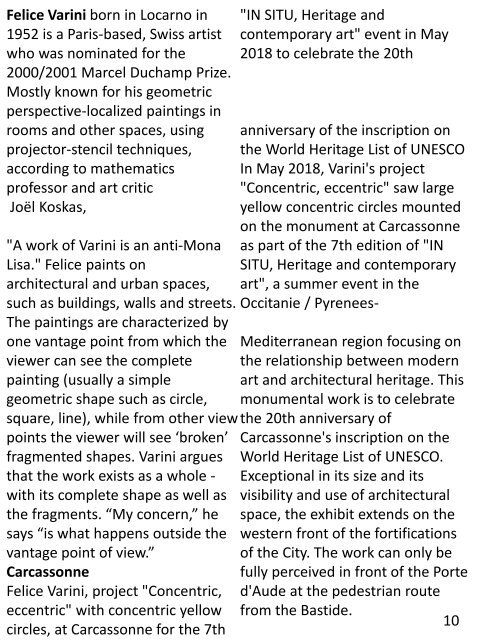Aziz Art October 2018
History of art(west and Iranian)-contemporary art History of art(west and Iranian)-contemporary art
Felice Varini born in Locarno in 1952 is a Paris-based, Swiss artist who was nominated for the 2000/2001 Marcel Duchamp Prize. Mostly known for his geometric perspective-localized paintings in rooms and other spaces, using projector-stencil techniques, according to mathematics professor and art critic Joël Koskas, "A work of Varini is an anti-Mona Lisa." Felice paints on architectural and urban spaces, such as buildings, walls and streets. The paintings are characterized by one vantage point from which the viewer can see the complete painting (usually a simple geometric shape such as circle, square, line), while from other view points the viewer will see ‘broken’ fragmented shapes. Varini argues that the work exists as a whole - with its complete shape as well as the fragments. “My concern,” he says “is what happens outside the vantage point of view.” Carcassonne Felice Varini, project "Concentric, eccentric" with concentric yellow circles, at Carcassonne for the 7th "IN SITU, Heritage and contemporary art" event in May 2018 to celebrate the 20th anniversary of the inscription on the World Heritage List of UNESCO In May 2018, Varini's project "Concentric, eccentric" saw large yellow concentric circles mounted on the monument at Carcassonne as part of the 7th edition of "IN SITU, Heritage and contemporary art", a summer event in the Occitanie / Pyrenees- Mediterranean region focusing on the relationship between modern art and architectural heritage. This monumental work is to celebrate the 20th anniversary of Carcassonne's inscription on the World Heritage List of UNESCO. Exceptional in its size and its visibility and use of architectural space, the exhibit extends on the western front of the fortifications of the City. The work can only be fully perceived in front of the Porte d'Aude at the pedestrian route from the Bastide. 10
The circles of yellow colour consist of thin, painted aluminium sheets, spread like waves of time and space, fragmenting and recomposing the geometry of the circles on the towers and curtain walls of the fortifications. The work will be visible from May to
- Page 1 and 2: AZIZ ART October 2018 František Ku
- Page 3: František Kupka 23 September 1871
- Page 6: Margit Rowell described his paintin
- Page 10: Parallel to his artistic practice,
- Page 17 and 18: Dia Azzawi born 1939 is an Iraqi bo
- Page 20 and 21: This group promoted the idea of fre
- Page 22 and 23: A number of his works, formerly hel
Felice Varini born in Locarno in<br />
1952 is a Paris-based, Swiss artist<br />
who was nominated for the<br />
2000/2001 Marcel Duchamp Prize.<br />
Mostly known for his geometric<br />
perspective-localized paintings in<br />
rooms and other spaces, using<br />
projector-stencil techniques,<br />
according to mathematics<br />
professor and art critic<br />
Joël Koskas,<br />
"A work of Varini is an anti-Mona<br />
Lisa." Felice paints on<br />
architectural and urban spaces,<br />
such as buildings, walls and streets.<br />
The paintings are characterized by<br />
one vantage point from which the<br />
viewer can see the complete<br />
painting (usually a simple<br />
geometric shape such as circle,<br />
square, line), while from other view<br />
points the viewer will see ‘broken’<br />
fragmented shapes. Varini argues<br />
that the work exists as a whole -<br />
with its complete shape as well as<br />
the fragments. “My concern,” he<br />
says “is what happens outside the<br />
vantage point of view.”<br />
Carcassonne<br />
Felice Varini, project "Concentric,<br />
eccentric" with concentric yellow<br />
circles, at Carcassonne for the 7th<br />
"IN SITU, Heritage and<br />
contemporary art" event in May<br />
<strong>2018</strong> to celebrate the 20th<br />
anniversary of the inscription on<br />
the World Heritage List of UNESCO<br />
In May <strong>2018</strong>, Varini's project<br />
"Concentric, eccentric" saw large<br />
yellow concentric circles mounted<br />
on the monument at Carcassonne<br />
as part of the 7th edition of "IN<br />
SITU, Heritage and contemporary<br />
art", a summer event in the<br />
Occitanie / Pyrenees-<br />
Mediterranean region focusing on<br />
the relationship between modern<br />
art and architectural heritage. This<br />
monumental work is to celebrate<br />
the 20th anniversary of<br />
Carcassonne's inscription on the<br />
World Heritage List of UNESCO.<br />
Exceptional in its size and its<br />
visibility and use of architectural<br />
space, the exhibit extends on the<br />
western front of the fortifications<br />
of the City. The work can only be<br />
fully perceived in front of the Porte<br />
d'Aude at the pedestrian route<br />
from the Bastide.<br />
10



